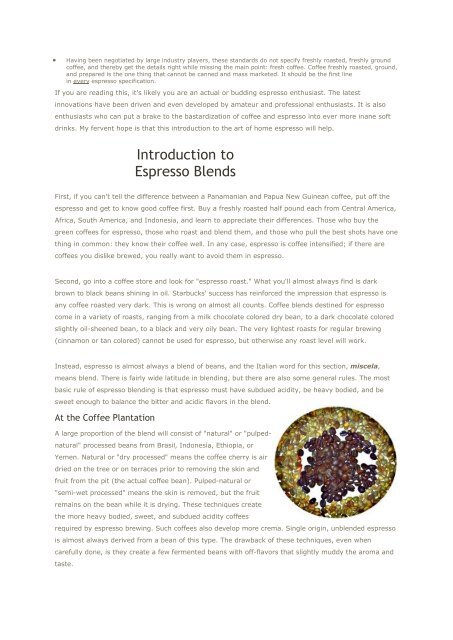The Home Barista's Guide to Espresso - Coffee Prince in Surat
The Home Barista's Guide to Espresso - Coffee Prince in Surat
The Home Barista's Guide to Espresso - Coffee Prince in Surat
You also want an ePaper? Increase the reach of your titles
YUMPU automatically turns print PDFs into web optimized ePapers that Google loves.
Hav<strong>in</strong>g been negotiated by large <strong>in</strong>dustry players, these standards do not specify freshly roasted, freshly groundcoffee, and thereby get the details right while miss<strong>in</strong>g the ma<strong>in</strong> po<strong>in</strong>t: fresh coffee. <strong>Coffee</strong> freshly roasted, ground,and prepared is the one th<strong>in</strong>g that cannot be canned and mass marketed. It should be the first l<strong>in</strong>e<strong>in</strong> every espresso specification.If you are read<strong>in</strong>g this, it's likely you are an actual or budd<strong>in</strong>g espresso enthusiast. <strong>The</strong> latest<strong>in</strong>novations have been driven and even developed by amateur and professional enthusiasts. It is alsoenthusiasts who can put a brake <strong>to</strong> the bastardization of coffee and espresso <strong>in</strong><strong>to</strong> ever more <strong>in</strong>ane softdr<strong>in</strong>ks. My fervent hope is that this <strong>in</strong>troduction <strong>to</strong> the art of home espresso will help.Introduction <strong>to</strong><strong>Espresso</strong> BlendsFirst, if you can't tell the difference between a Panamanian and Papua New Gu<strong>in</strong>ean coffee, put off theespresso and get <strong>to</strong> know good coffee first. Buy a freshly roasted half pound each from Central America,Africa, South America, and Indonesia, and learn <strong>to</strong> appreciate their differences. Those who buy thegreen coffees for espresso, those who roast and blend them, and those who pull the best shots have oneth<strong>in</strong>g <strong>in</strong> common: they know their coffee well. In any case, espresso is coffee <strong>in</strong>tensified; if there arecoffees you dislike brewed, you really want <strong>to</strong> avoid them <strong>in</strong> espresso.Second, go <strong>in</strong><strong>to</strong> a coffee s<strong>to</strong>re and look for "espresso roast." What you'll almost always f<strong>in</strong>d is darkbrown <strong>to</strong> black beans sh<strong>in</strong><strong>in</strong>g <strong>in</strong> oil. Starbucks' success has re<strong>in</strong>forced the impression that espresso isany coffee roasted very dark. This is wrong on almost all counts. <strong>Coffee</strong> blends dest<strong>in</strong>ed for espressocome <strong>in</strong> a variety of roasts, rang<strong>in</strong>g from a milk chocolate colored dry bean, <strong>to</strong> a dark chocolate coloredslightly oil-sheened bean, <strong>to</strong> a black and very oily bean. <strong>The</strong> very lightest roasts for regular brew<strong>in</strong>g(c<strong>in</strong>namon or tan colored) cannot be used for espresso, but otherwise any roast level will work.Instead, espresso is almost always a blend of beans, and the Italian word for this section, miscela,means blend. <strong>The</strong>re is fairly wide latitude <strong>in</strong> blend<strong>in</strong>g, but there are also some general rules. <strong>The</strong> mostbasic rule of espresso blend<strong>in</strong>g is that espresso must have subdued acidity, be heavy bodied, and besweet enough <strong>to</strong> balance the bitter and acidic flavors <strong>in</strong> the blend.At the <strong>Coffee</strong> PlantationA large proportion of the blend will consist of "natural" or "pulpednatural"processed beans from Brasil, Indonesia, Ethiopia, orYemen. Natural or "dry processed" means the coffee cherry is airdried on the tree or on terraces prior <strong>to</strong> remov<strong>in</strong>g the sk<strong>in</strong> andfruit from the pit (the actual coffee bean). Pulped-natural or"semi-wet processed" means the sk<strong>in</strong> is removed, but the fruitrema<strong>in</strong>s on the bean while it is dry<strong>in</strong>g. <strong>The</strong>se techniques createthe more heavy bodied, sweet, and subdued acidity coffeesrequired by espresso brew<strong>in</strong>g. Such coffees also develop more crema. S<strong>in</strong>gle orig<strong>in</strong>, unblended espressois almost always derived from a bean of this type. <strong>The</strong> drawback of these techniques, even whencarefully done, is they create a few fermented beans with off-flavors that slightly muddy the aroma andtaste.


